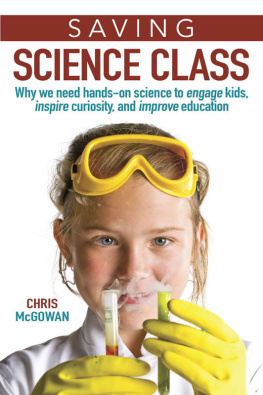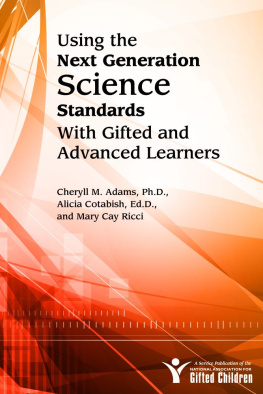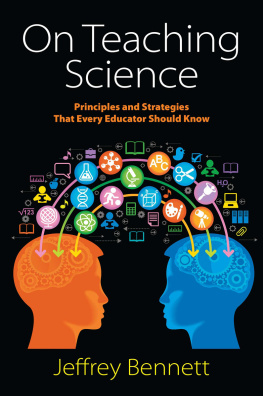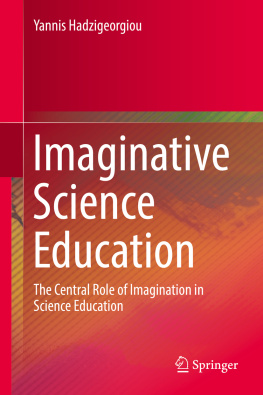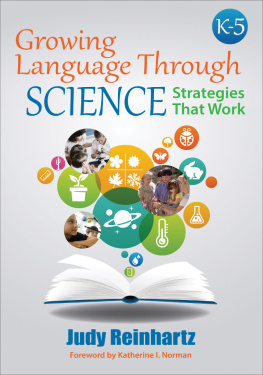A decade ago Time magazine, to which I have subscribed for eons, ran a cover article titled Is America Flunking Science? The cover depicted a schoolboy, lab coat blackened by an obviously disastrous experiment. This illuminating article is acknowledged as the spark that eventually led to my writing of this book.
First and foremost, I thank Steven L. Mitchell for his enthusiastic response to my proposal to write this book, and for his subsequent acquisition of the manuscript. As my editor, he gave valuable input and direction from the outset, helping me keep the narrative on course. His patient guidance through some of the nuances of the house style was very much appreciated; so too was his timely tuition on footnoting. Thank you, Steven, for this and more.
Of all my previous books, this was by far the most arduous and demanding, primarily because of the subject matter. Owing to the contentious nature of some aspects of the work, I sought the opinions of some of my peers on certain chapters. For their valuable comments and helpful discussions, I thank professors Jaime Alvarado, Judy Massare, Ryosuke Motani, and Jeffrey Thomason. I am deeply grateful to each one of you for your input and much appreciated support.
Several other highly respected academics have taken time from their busy schedules to review advanced reading copies of this book and make commentaries on its content. For their generous support and much appreciated words, I thank William C. Burger, Peter Dodson, Taner Edis, Stephen Gatesy, Quanyu Huang, Colin Pask, Frank Ryan, and Scott Sampson; Judy Massare is also thanked here too.
One unexpected bonus of publishing with Prometheus Books has been working with such a dedicated and accommodating group of professionals. These committed people went out of their way to help me through every stage of the project. One of the first was Hanna Etu, a wellspring of important information, from copyright regulations and sources of illustrations, to giving feedback on certain things I wrote. Hanna was a steadying hand on the tiller, always available when neededthe cheerful voice at the end of the phone; the respondent to my emails, almost as soon as I had pressed the send button. I later learned that she had also emended all my endnotes, so as to conform to the house style. I am truly grateful for all her support.
Cate Roberts-Abel, who first assisted me with important feedback on the quality of some of my illustrations, helpfully steered me through the production process. Her much appreciated advice and assistance included giving invaluable insights into indexing, providing me with informative reading material and exemplars of indices from other books. Cate's timely resolution of some unforeseen problems in the advanced reading copy saved me from a good deal of trouble and angst.
I was exceedingly fortunate to have someone of such meticulous care as Sheila Stewart as my copyeditornothing slipped past her sharp eyes. I am sincerely grateful to her for the errors she caught, the facts she checked, the points she raised, and for the numerous improvements that resulted from her close attention to detail. I also thank her for the practical assistance she gave me throughout the editing process, with valuable discussions, opinions, and adviceI'll miss our phone calls. Her genial forbearance of my many minor emendations during the eleventh hour is also greatly appreciated.
Cheryl Quimba, my publicist, has been unstinting in the help she has given me in my attempts to bring this book to people's attention. I thank her for critically reading drafts of proposals I have written, and for giving valuable feedback and advice for pursuing certain avenues of potential interest. I am also grateful to her for following up on some of my suggestions.
Early on in the process I had the pleasure of working with Mark Hall, the communications editor, who drafted the catalog description of the book. Much impressed by his distillation of the essence of my work, I had few contributions to make to his encapsulation of the content.
Freelancer Jeff Schaller designed the front cover, with in-house assistance from Jackie Cooke, who worked on the spine and back cover. The book was designed by Bruce Carle, Prometheus's typesetter. Jeff Curry gave last-minute help, for which I am truly grateful. My thanks to you all.
I thank Jim Almond of Shropshire, England, for his magnificent photographs of an Arctic tern and of an osprey. My thanks also to Duade Paton of New South Wales, Australia, for his superb image of an albatross.
For her generous help in obtaining high-resolution images of the Wright brothers aircraft and the facsimile of their wind tunnel I thank Stephanie Kays of Denison University, Granville, Ohio, formerly the archivist at Wright State University, Dayton, Ohio. For their assistance in obtaining an image of Newcomen's engine I thank Mark Bainbridge and Rene Prud'Homme of Worcester College, Oxford, and Jen Burford and Samantha Sherbourne of the Bodleian Libraries, Oxford.
My sincere thanks to Richard Berman and his fellow science teachers at Newmarket High School, Ontario. These dedicated teachers gave so generously of their time and hospitality, and welcomed me into the science lab. I also thank the students for making me feel so completely at home. Witnessing the mutual respect, enthusiasm, and camaraderie within that lab was an inspiring experience.
Steven L. Mitchell will attest to the computer problems I encountered during the writing of this book. Worst among these was a malware infection, occurring at a most critical time. For resolving that issue, and many more beside, I thank the computer wizards at easyTechCare Inc, North York, Ontario, whose services I have been using for many years. I would also like to thank the very helpful staff at my local Staples store in Aurora, Ontario, for everything from image scanning and printing, to ordering certain glues not available on their shelves, and resolving a terminal printer problem.
Working with the incomparably talented Julian Mulock on yet another book was a great joy. Julian has been illustrating my scientific endeavors since our early days of working at the Royal Ontario Museum, a tradition that continued long after we both left. Because of prior commitments, he was unable to commence work until perilously close to the illustration deadline. Unfazed, he completed the task with the professional acumen I have come to admire over all the years. I thank him for his splendid drawings that enliven the pages that follow.
Liz, my wonderfully supportive wife, has been the paragon of patience and understanding throughout my self-imposed year of withdrawal from normal life. While ensconced in my office from pre-dawn to post-dusk, she kept me isolated from everything unrelated to working on this book. She also read everything I wrote, giving valuable comments, criticisms, and constructive advice, which were of immeasurable benefit. No words can express my gratitude for this, and for everything else. We are indeed fortunate to share our life together.
Mr. Jordan captured my attention back in the early fifties, along with the attention of all the other twelve-year-old boys in my class. Taking an empty gallon can, he poured in a splash of water and then placed it on a tripod over a Bunsen burner. Once steam was billowing, he removed the can from the flame, quickly screwed on the lid, and set it down on the bench.
Nothing happened.
We waited patiently, but still nothing happened. The seconds ticked by and there were some whispers from the back of the class. And then it happened. With a loud metallic crunch that made everyone jump, the can was crushed almost flat. Holding up the can for all to see only added to our wonderit looked as if it had been run over by a double-decker bus.

